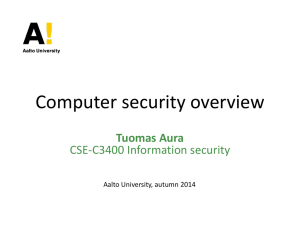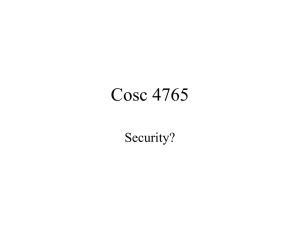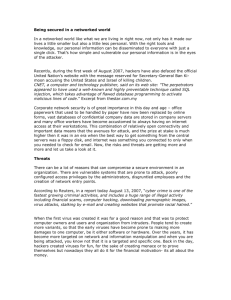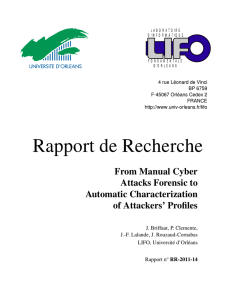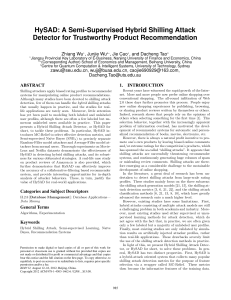01 Overview of security
advertisement
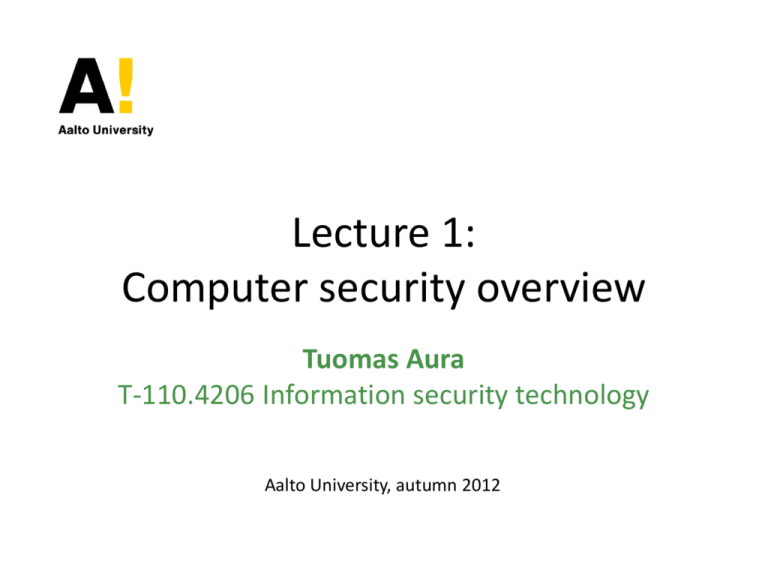
Lecture 1: Computer security overview Tuomas Aura T-110.4206 Information security technology Aalto University, autumn 2012 Outline Timeline of computer security What is security anyway? Summary 2 TIMELINE OF COMPUTER SECURITY 3 70s Multi-user operating systems need for protection Access control models: multi-level security, BellLaPadula 1976, BIBA 1977 DES encryption algorithm 1976 cryptanalysis, need for key distribution Public-key cryptosystems: Diffie-Hellman 1976, RSA 1978 Key distribution: certificates 1978 key exchange protocols: Needham-Schroeder 1978 4 80s Orange Book 1985: mandatory access control Commercial security models from accounting and auditing rules: Clark-Wilson 1987 X.509 PKI 1988 IBM PC software copy protection floppy disk virus 1987 Internet Morris worm 1988 5 90s More methodological approach to security research: Information flow security Secure operating systems: SEVMS until 1996 Formal analysis of key exchange protocols Wider availability of cryptography – – – – – Cellular networks: GSM 1991 Open-source cryptography: PGP 1991 Password sniffers SSH 1995 Commercial Internet SSL and VeriSign CA 1995 RSA patent expired in 2000 Spam: Cantor and Siegel 1994 PKI criticism trust management research User authentication beyond passwords Intrusion detection Macro virus: Melissa 1999 DRM 6 2000s Fast-spreading Internet worms: Code Red 2001 secure programming secure programming languages security analysis and testing tools Botnets, spyware malware analysis Computer crime: phishing Enterprise identity management Security in mobility, Grid, ah-hoc networks, sensor networks Mobile device operating systems Social networks, privacy concerns 7 2010s Cloud computing Internet of Things Cyberwar, critical infrastructure protection App security Vehicular communication Mobile payments? Smart grid security, home automation 8 WHAT IS SECURITY 9 What is security When talking about security, we are concerned about bad events caused with malicious intent – Security vs. reliability Terminology: – Threat = bad event that might happen – Attack = someone intentionally causes the bad thing to happen – Vulnerability = weakness in an information system that enables an attack – Exploit = implementation of an attack – Risk = probability of an attack × damage in dollars Security Goals CIA = confidentiality, integrity, availability – Confidentiality — protection of secrets – Integrity — only authorized modification of data and system configuration – Availability — no denial of service, business continuity Examples: secret agent names, web server The CIA model is a good starting point but not all: – Access control — no unauthorized use of resources – Privacy — control of personal data and space – What else? 11 Areas of IT security [Gollmann] Computer security — security of end hosts and client/server systems – Focus: access control in operating systems – Example: access control lists for file systems Network security — security of communication – Focus: protecting data on the wire – Example: encryption to prevent sniffing Application security — security of services to end users and businesses – Focus: application-specific trust relations – Example: secure and legally binding bank transactions 12 Viewpoints to security Cryptography (mathematics) Computer security (systems research) Network security (computer networking) Software security (software engineering, programming languages and tools) Formal methods for security (theoretical CS) Hardware security (HW engineering) Human aspects of security (usability, sociology) Security management (information-systems management, enterprise security) Economics of security, laws and regulation You cannot be just a security expert! Need broader understanding of the systems and applications 13 Security is a continuous process Continuous race between attackers and defenders – Attackers are creative No security mechanisms will stop all attacks; attackers just move to new methods and targets – Some types of attacks can be eliminated but others will take their place – Compare with crime statistics: Do locks or prison reduce crime in the long term? Security mechanisms will fail and new threats will arise → Monitoring and auditing for new attacks → Contingency planning: how to recover from a breach 14 Cost vs. benefit Rational attackers compare the cost of an attack with the gains from it – Attackers look for the weakest link; thus, little is gained by strengthening the already strong bits Rational defenders compare the risk of an attack with the cost of implementing defenses – Lampson: “Perfect security is the enemy of good security” But human behavior is not always rational: – Attackers follow each other and flock all to the same path – Defenders buy a peace of mind; avoid personal liability by doing what everyone else does → Many events are explained better by group behavior than rational choice 15 Proactive vs. reactive security Technical prevention: design systems to prevent, discourage and mitigate attacks – If attack cannot be prevented, increase its cost and control damage Detection and reaction: detect attacks and take measures to stop them, or to punish the guilty In open networks, attacks happen all the time – We can detect port scans, spam, phishing etc., yet can do little to stop it or to punish attackers → Technical prevention and mitigation must be the primary defence However, detection is needed to monitor the effectiveness of the technical prevention 16 Who is the attacker? We partition the world into good and bad entities – Honest parties vs. attackers, red vs. blue – Good ones follow specification, bad ones do not – Different partitions lead to different perspectives on the security of the same system Typical attackers: – – – – – – Curious or dishonest individuals — for personal gain Hackers, crackers, script kiddies — for challenge and reputation Companies — for economic intelligence and marketing Security agencies — NSA, FAPSI, GCHQ, DGSE, etc. Military SIGINT — strategic and tactical intelligence, cyber war Organized criminals — for money Often, not all types of attackers matter – E.g. who would you not want to read your diary or email? 17 Ethical considerations Who is allowed to attack and when? – Violations of policy vs. actual damage Are security policies for us or against us? – – – – University policy vs. active learning Difference between research or QA and crime? Privacy of human subjects Getting work done vs. following rules Security is commonly used as an excuse for indecision and power grabs Ethics and engineering: – What is your technology used for? – Is your product secure enough for release? 19 SUMMARY 20 Reading material Dieter Gollmann: Computer Security, 2nd ed. chapters 1–2; 3rd ed. chapters 1 and 3 Matt Bishop: Introduction to computer security, chapter 1 (http://nob.cs.ucdavis.edu/book/book-intro/intro01.pdf) Edward Amoroso: Fundamentals of Computer Security Technology, chapter 1 Ross Anderson: Security Engineering, 2nd ed., chapter 1 (1st ed. http://www.cl.cam.ac.uk/~rja14/Papers/SE-01.pdf) 23 Exercises What security threats and goals are there in the postal (paper mail) system? – What different entities are there in the postal system? – Do they have the same of different security concerns? – Who could be the attacker? Does the answer change if you think from a different entity’s viewpoint? Who are insiders? – Can you think of attacks where it is necessary for two or more malicious parties to collude? What is the role of laws and punishment in computer security? Can the development of information security technology be unethical, or is engineering value neutral? Give examples. When is it (or when could it be) ok for you to attack against IT systems? Give examples. How do the viewpoints of security practitioners (e.g. system admin or company security officer) and academic researchers differ? 24
